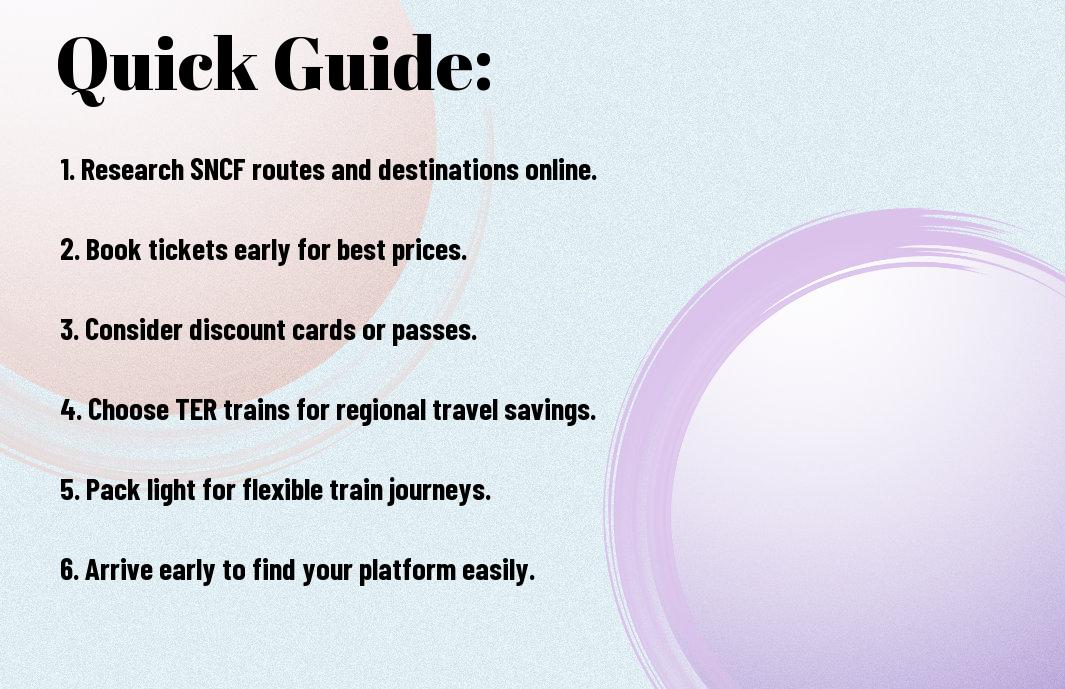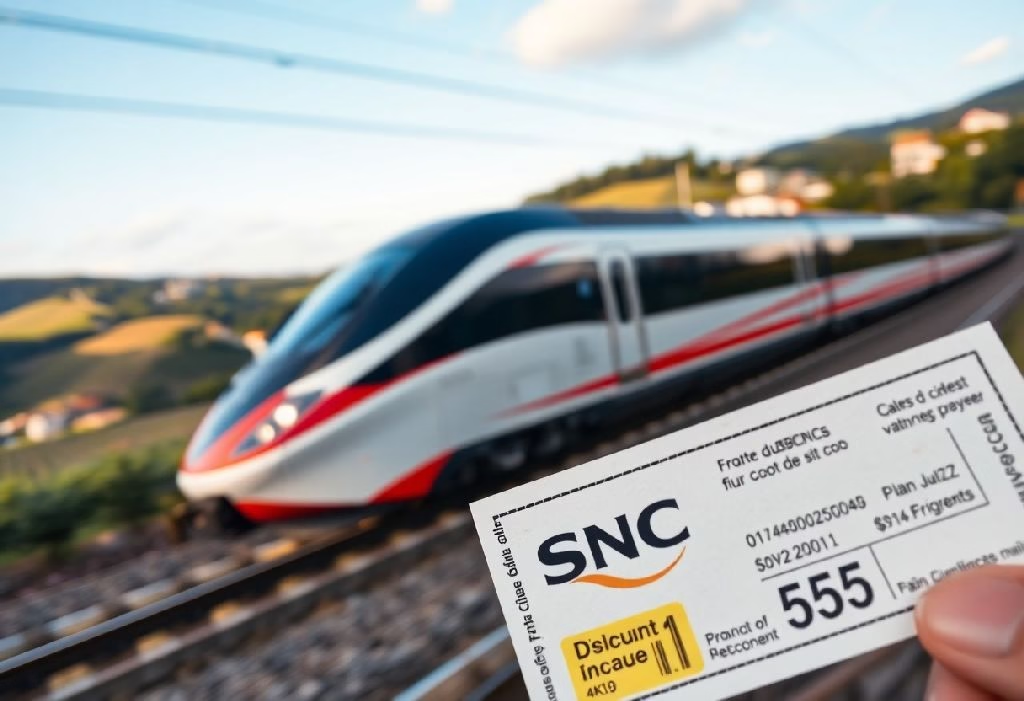France has one of the most efficient and scenic train networks in the world. Whether you’re zipping between cities on a high-speed TGV or exploring the countryside on a local TER, train travel offers a comfortable, eco-friendly, and often surprisingly affordable way to see the country. This guide covers everything you need to know, from understanding the types of trains to booking the cheapest tickets.
Key Takeaways:
- Understanding how SNCF operates and the types of trains available can help you plan efficient and comfortable travel across France.
- Booking tickets in advance and utilizing SNCF discount options can significantly reduce the cost of train travel.
- Exploring regional routes and using budget train passes offers an affordable way to experience diverse destinations throughout France.
What Are the Different Types of Trains in France?
France offers a variety of train options suited to different travel needs. Whether you’re seeking speed, savings, or scenic views, there’s a train type for every traveler.
Understanding TGV and High-Speed Trains
The TGV (Train à Grande Vitesse) is the crown jewel of French rail travel. Operated by SNCF, TGV trains can reach speeds of up to 320 km/h (199 mph), making them ideal for long-distance travel. Routes like Paris to Lyon or Paris to Marseille are covered in just a few hours. TGVs offer first and second-class seating, quiet zones, onboard Wi-Fi (on many routes), and snack bars. Reservations are required, and prices vary by demand, but early bookings can yield significant savings.
Regional Trains vs. Intercity Trains
Regional trains (TER – Transport Express Régional) are slower, non-reserved trains that connect smaller towns and rural areas. They’re perfect for reaching less touristy destinations or for daily commuting. Intercités trains fill the gap between TGV and TER—offering medium-distance travel with comfortable seats and fewer stops than TER, but without the speed of TGV. Intercités also require reservations on some routes, but generally cost less than TGV.
Ouigo Trains: Affordable Travel Options
Ouigo is SNCF’s budget-friendly alternative to TGV. These high-speed trains operate on many major routes but cut costs by offering no-frills services. Think of it as a low-cost airline on rails: limited luggage, no Wi-Fi, and fewer onboard amenities. Many Ouigo trains depart from secondary stations, so pay attention to departure points. If you book early, tickets can cost as little as €10, making them one of the best deals in European rail travel.

How to Buy Train Tickets in France?
Navigating France’s train ticketing system is easy once you know where to look and how to time your purchase. Here’s how to secure the best fares with minimal hassle.
Step-by-Step Guide to Buying Train Tickets Online
- Visit the official SNCF Connect website or use the SNCF Connect mobile app.
- Input your departure and arrival stations, travel date, and passenger details.
- Select your preferred train (TGV, TER, Ouigo, or Intercités) from the list of available options.
- Choose your fare type (non-flexible, semi-flexible, or fully refundable).
- Proceed to checkout, enter your payment information, and confirm the booking.
- Receive your e-ticket via email or directly in the app.
Where to Purchase Train Tickets in France
There are several convenient ways to buy train tickets in France—online, at stations, or even through travel agencies. Each method has its advantages.
- Online: SNCF Connect and Trainline are the most reliable platforms.
- At the station: Use ticket machines (with English-language options) or speak with an agent at the counter.
- Travel agencies and tourist offices: Many can book tickets on your behalf.
- Mobile apps: Both SNCF Connect and Trainline have apps for easy access to bookings and real-time updates.
Tips for Finding Cheap Train Tickets
Want to travel for less? These tips will help you unlock the lowest fares and avoid overpaying.
- Book early: Prices for TGV and Ouigo rise as the departure date nears.
- Travel during off-peak times: Mid-week and midday trains are often cheaper.
- Use discount cards: Cards like Carte Avantage offer up to 30% off.
- Compare platforms: Sometimes, prices vary slightly between SNCF Connect and Trainline.
- Be flexible: Adjusting your travel time by an hour or two can lead to big savings.
What Is the SNCF and How Does It Operate?
For travelers eager to explore France, the SNCF (Société Nationale des Chemins de fer Français) is your go-to national railway company, offering an extensive and efficient train network. It operates both high-speed TGV trains and regional services, ensuring you can easily reach popular cities and charming towns alike. To get a detailed understanding, you might find Train travel in France: A guide to SNCF very helpful in planning your journey with expert tips and advice.
An Overview of SNCF Services
SNCF (Société Nationale des Chemins de fer Français) is France’s national railway company. It manages a vast network that includes:
- TGV: High-speed intercity trains.
- TER: Local and regional trains.
- Intercités: Medium-distance trains.
- Ouigo: Budget high-speed service. It also runs international routes such as Thalys (to Belgium), Eurostar (to the UK), and Lyria (to Switzerland).
How to Book Your Train with SNCF
Booking with SNCF is simple via the SNCF Connect platform. You can:
- Search by destination, date, and class.
- Filter by cheapest or fastest routes.
- Opt for paperless e-tickets or print-at-home options.
- Select your seat and class. SNCF often runs promotions, so check their site for seasonal deals.
SNCF’s Mobile App: A Convenient Option
The SNCF Connect app makes travel easier by letting you:
- Book tickets in minutes.
- Get real-time train updates and platform info.
- Store your e-ticket.
- Cancel or exchange tickets (depending on the fare type).
- Access customer service directly. If you’re moving around frequently or planning multi-leg journeys, the app is a must-have.
How to Travel Around France by Train?
France’s train network connects cities, towns, and regions with remarkable efficiency. Here’s how to make the most of it when planning your itinerary.
Planning Your Journey: Key Destinations
France is compact and well-connected. Some top routes:
- Paris to Lyon: 2 hours via TGV.
- Paris to Bordeaux: 2 hours.
- Paris to Marseille: 3 hours.
- Paris to Strasbourg: 2 hours.
- Lyon to Avignon: 1 hour.
Use Paris as your hub—it connects to almost every region in France.
Traveling from Paris to the South of France
Southern France is a train-lover’s dream. TGVs take you directly from Paris to:
- Avignon: For Roman ruins and medieval streets.
- Aix-en-Provence: Known for art and lavender fields.
- Marseille: France’s Mediterranean melting pot.
- Nice: Stunning coastal views via the TGV or TER. The scenery transitions from urban to vineyards to mountains to sea—all in a few hours.
Using a Rail Pass for Flexible Travel
A Eurail France Pass (for non-EU residents) or Interrail France Pass (for EU citizens) lets you travel multiple days within a month. Great for:
- Spontaneous travel.
- Visiting many cities in one trip.
- Families or groups wanting flexibility. Note: TGV and Intercités require reservations even with a pass, often for a small fee (€10-€20).
What Are the Benefits of Train Travel in France?
From eco-conscious transit to stress-free comfort, France’s railways deliver more than just transportation. Here’s why taking the train is often the best way to go.
Comfort and Convenience of French Trains
 French trains are built for comfort:
French trains are built for comfort:
- Spacious seats and legroom.
- Quiet carriages for uninterrupted work or rest.
- Direct city-center-to-city-center travel—no airports far from town.
- Dining cars on many long-distance trains. Plus, the stations are usually walkable to major attractions.
Environmental Benefits of Traveling by Train
Rail travel is one of the greenest ways to explore France. Compared to cars or planes, trains:
- Produce significantly less CO2.
- Use electricity over fossil fuels.
- Reduce traffic and urban congestion.
Exploring France’s Scenic Routes
Trains offer incredible views on routes like:
- The Alps Line: Grenoble to Chamonix.
- The Loire Valley: Past castles and vineyards.
- The Riviera: Marseille to Nice hugs the coast.
- Normandy: Paris to Bayeux reveals rolling green hills and WWII landmarks. Bring your camera and enjoy the ride.
How to Navigate the French Train System?
New to French trains? Understanding how the system works will ensure a smooth ride from start to finish.
Understanding Train Schedules and Timetables
- French train times use the 24-hour clock.
- Look for your train number and platform on station displays.
- Arrive early—platform info appears ~20 minutes before departure.
- For TERs, boarding is open seating, while TGVs and Ouigo are assigned.
Tips for First-Time Travelers on French Trains
- Validate paper tickets in yellow machines before boarding.
- Hold on to your ticket—inspectors check them en route.
- Don’t count on announcements in English—use apps or signage.
- Many stations have lockers and bathrooms, but bring coins.
Safety and Etiquette When Traveling by Train
- Keep bags with you or in racks.
- Don’t block aisles or seats with luggage.
- Let people off before getting on.
- Quiet cars mean no loud phone calls.
- At night, sit near others and stay alert at stations.
What Are the Best Practices for Traveling by Train in France?
To get the most from your train experience in France, it’s worth following a few expert tips. These practical suggestions will help you ride like a local.
Essential Tips for a Smooth Train Journey
- Download the SNCF Connect app.
- Travel light: many stations have stairs but no elevators.
- Arrive at least 20 minutes before departure.
- Confirm platform info via app or screens.
- Bring snacks and water, especially for Ouigo.
What to Pack for Your Train Travel in France
- Compact suitcase or backpack.
- Portable charger.
- Translation app (e.g., Google Translate).
- Reusable water bottle.
- Travel pillow for longer rides.
- Light jacket (train cabins can vary in temperature).
How to Enjoy the Scenic Views from the Train
- Book a window seat.
- Avoid night trains if you want views.
- Keep your phone or camera handy.
- Watch for castles, vineyards, rivers, and coastlines—France delivers eye candy in every direction.
- Use the travel time to relax, write, or simply watch the country unfold outside your window.
Conclusion
In conclusion, exploring train travel in France with your SNCF guide opens up a world of affordable and convenient adventures. By using tips on finding cheap train tickets, you ensure your journeys are not only scenic but also budget-friendly. You’ll enjoy the ease of navigating France’s extensive rail network, making it simple to discover charming cities and beautiful countryside. With your newfound knowledge, every trip becomes a delightful experience, allowing you to focus on the joy of travel and the memories you create along the way.
FAQ
Q: How can I find the cheapest train tickets on SNCF?
A: To find the cheapest SNCF train tickets, it is best to book your trip well in advance, as prices tend to rise closer to the departure date. Use the official SNCF website or mobile app to compare prices and check for discounts, such as youth or senior reductions. Additionally, consider traveling during off-peak hours or on weekdays, when ticket prices are generally lower. Signing up for SNCF newsletters can also provide access to exclusive deals and promotional offers.
Q: What types of trains operate under SNCF and which should I choose for different travel needs?
A: SNCF operates several types of trains, including TGV (high-speed trains), Intercités (long-distance conventional trains), TER (regional trains), and Ouigo (low-cost high-speed services). For fast travel between major cities, TGV or Ouigo are ideal options. Intercités is suitable for routes not covered by high-speed trains but still connecting large towns. TER trains are perfect for exploring regions more thoroughly, as they stop at many local stations. Your choice depends on balancing speed, convenience, and price.
Q: What tips can help make train travel smoother when exploring France with SNCF?
A: When traveling by train with SNCF in France, it helps to arrive at the station early to navigate ticket validation machines and find your platform. Keep an eye on your train’s departure screen for any last-minute changes or delays. Make sure your ticket is either printed or available on your phone to show to conductors. Packing light and bringing snacks can improve comfort, especially on longer journeys. Finally, using regional maps and apps can assist with seamless connections to local public transport after your train arrives.

Hi, I’m Lily, a travel writer based in the UK who loves exploring everything from familiar hometown gems to the varied landscapes across Europe. Whether I’m strolling through charming coastal villages or hopping trains across the continent, I’m always on the lookout for authentic, unexpected stories and experiences.
My writing style is simple and relatable—think no-fuss guides to finding the best pasty in Cornwall or stress-free tips for getting around European cities. If there’s a great view, tasty food, or a bit of history involved, chances are I’m already scribbling notes about it.



